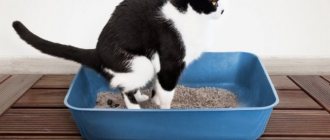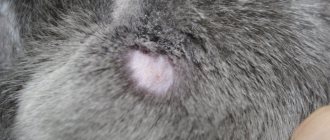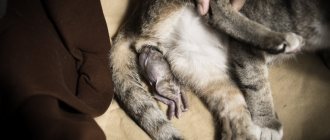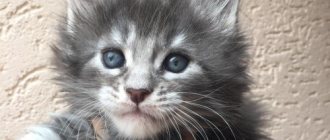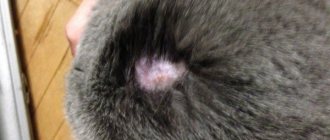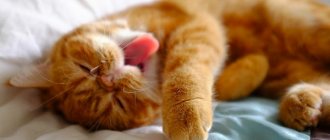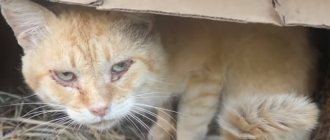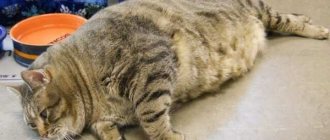Eosinophilic granuloma
Eosinophilic granuloma is an inflammatory disease of the oral mucosa and skin. As a rule, it occurs due to insect bites - fleas, mosquitoes or an allergic reaction to food components.
Symptoms:
- Single swollen areas in the oral cavity.
- Redness and swelling of the skin.
- Baldness at the site of redness.
- There is no pain or itching.
— Local lymph nodes swell.
- If lesions have developed in the mouth, the animal cannot eat and drink normally, and therefore signs of exhaustion and dehydration quickly increase.
Treatment:
Granuloma can only be cured with hormones, since there are no other means for this.
1. A course of antibiotic therapy.
2. Antihistamines, which can help in almost all cases, as they effectively relieve itching. This treatment is available at home, but you should still consult your veterinarian first.
3. Immunosuppressants such as cyclosporine or chlorambucil. They are useful if granuloma has developed against the background of autoimmune diseases.
4. Prescription of hydrocortisone. This drug also belongs to the hormonal category, but its use does not cause dangerous side effects.
============================================================================================================================================================================================
Dermatomycoses
Dermatomycoses are infectious zooanthroponotic diseases with characteristic lesions of the skin and its derivatives, caused by pathogenic dermatophyte fungi.
Among animals, the most common are: trichophytosis, microsporia, scab.
Microsporia and trichophytosis are combined under one common name “ringworm”.
Symptoms:
- With microsporia - the appearance of limited spots of peeling and the formation of crusts on the skin of the paws, muzzle, and torso. The hair in the affected areas is sparse and breaks off easily. Lesions can be focal or disseminated.
- In cases of trichophytosis, sharply limited foci with broken hair and a flaky scaly surface or areas of inflamed skin and its follicles form on the skin in the area of the head, neck, torso, base of the tail and limbs.
Treatment:
1. When choosing medications, special increased skin sensitivity should be taken into account, and therefore it is necessary to give preference to products that have minimal irritating and cauterizing effects: Vaganova ointment (Lysol - 30.0; birch tar - 50.0; sulfur color and ASD, fraction 3—100.0 each; petroleum jelly—800.0), SK-9—chlorinated turpentine (200–500 ml per 10 liters of water), ROSC preparation, trichocetine (in the form of 2% liniment), phenothiazine (5% fish oil solution).
2. For disseminated lesions, the use of the antibiotic griseofulvin is indicated. It is prescribed orally at a dose of 2 mg per 1 kg of animal weight for 8-15 days.
============================================================================================================================================================================================
Diagnosis of causes
It is not recommended to make a diagnosis yourself. It is necessary to show the cat to the veterinarian. First, the specialist will perform an external examination of the sick animal, after which he will interview the owners about any additional symptoms observed.
The doctor can clarify whether there is a connection between the appearance of symptoms and the time of year, whether the onset of sores was preceded by sudden changes in lifestyle, whether the food has changed, whether the animal has taken medications (including anti-parasitic drugs), and whether vaccinations have recently been given.
Diagnostic tests will be performed if necessary. If ringworm is suspected, an ultraviolet lamp is used. The presence of parasites and fungi is checked using skin scrapings. A number of infectious pathologies are confirmed by biopsy results. If a food allergy is suspected, the animal will be placed on a hypoallergenic diet.
Flea dermatitis
Flea dermatitis is an inflammation of the skin caused by flea bites and an allergic reaction to their saliva. The severity of symptoms does not always depend on the number of parasites; sometimes one bite is enough for an intense pathological process.
Symptoms:
- Constant itching leading to scratching.
- Hair loss and the appearance of small nodules, most often on the back, lower back, sacrum, abdomen and thighs.
- Weeping areas in the natural folds of the skin (groin, armpits).
- Areas of redness with papules that subsequently crust over
- Hyperpigmentation.
- Often scratches become contaminated with pathological microflora, causing bacterial or fungal infections that aggravate the animal’s condition.
- The cat behaves restlessly, and in severe cases the appetite worsens.
Treatment:
1. Treat the animal with antiparasitic agents - drops, spray, shampoos. D
2. To kill fleas in the environment, insecticide solutions are used to wash bedding and rugs, wash floors, paying special attention to cracks and the space under baseboards.
3. To prevent scratching, put a protective collar on the cat and trim its claws. If the animal's itching was caused only by discomfort from flea bites and was not complicated by scratching or secondary infection, then no additional treatment is required.
In case of development of an allergic reaction and the presence of complications, the following drugs are additionally prescribed:
- Corticosteroid hormones are the main remedy for eliminating itching and inflammation in flea dermatitis. They are used both systemically and in the form of local forms (shampoos, ointments). In case of secondary infection, they are not used; in extreme cases, occasional use in small doses is allowed, mainly in the form of local forms.
- For severe itching and anxiety, sedatives are used.
- Drying agents - prescribed when there are wet areas of the skin.
- Antibacterial and antifungal agents - for minor scratching, they are used in the form of combined local preparations (for example, Sanoderm). When a secondary infection develops, systemic forms are prescribed.
- Multivitamin complexes with biotin and fatty acids accelerate the restoration of skin and coat.
If there is significant damage to the skin, it is advisable to trim the cat. This will make it easier to care for and heal scratches, and subsequently uniform and healthy hair will grow back.
============================================================================================================================================================================================
Contagious dermatitis
Skin diseases are caused by the following groups of contagions:
recommended articles:
- Grooming a cat, is it worth using scissors?
- Papillomas and warts in cats
- Bacteria.
- Microscopic fungi.
- Parasites.
Skin diseases caused by bacteria include the following:
- Microbial dermatitis.
- Carbunculosis.
- Folliculitis. Furunculosis.
Microbial dermatitis
The causative agents of the disease are predominantly staphylococci. Light scratching precedes the appearance of reddish lumps - papules, which turn into pustules, and ulcers form.
If a bacterial infection develops at the site of an injury or bite, the inflammation may take the form of a tumor filled with pus - an abscess. After opening, the foul-smelling contents of the pathological cavities flow out, dry out, and scabs form adjacent to newly formed papules and vesicles.
Carbunculosis
Purulent inflammation of the sebaceous glands simultaneously with the adjacent hair follicles is called carbunculosis. This is a type of bacterial dermatitis. First, the gland ducts become clogged and a pimple forms. The accumulating secretion becomes infected with banal microflora, mainly cocci, and the surrounding textures become necrotic. Multiple foci of suppuration merge into a weeping ulcer.
Folliculitis
First, as a result of insect bites or scratching, the integrity of the skin is compromised. Small scratches become infected with cocci located on the cat's skin. The center of abscess formation is most often the hair follicle. The disease is not as severe as carbunculosis.
Treatment
Treatment of all dermatitis of bacterial etiology combines treatment with external antiseptic anti-inflammatory agents, diet therapy, and immunocorrection.
Among skin diseases caused by fungi, phytodermatitis, colloquially called lichen, is distinguished. Classification by pathogen distinguishes mainly the following pathologies:
- Microsporia.
- Trichophytosis.
The most common is microsporia. The disease most often develops with weakened immunity. Bacterial infections occur. It also happens that phytodermatitis occurs against the background of staphylococcosis or subcutaneous mites.
Lichen
Fungal skin lesions may be accompanied by severe itching or may not occur. Areas of alopecia with smooth or flaky skin appear. Scales, crusts, and ulcers may form on the surface of the lesions. A classic sign of lichen is the appearance of round, hairless spots with a red border. The hairs around the pathological lesions become thinner and break off, and the affected surface looks shaved.
An accurate diagnosis is made on the basis of microscopic examination of skin scrapings and seeding of pathological material.
The disease is transmitted to humans. The treatment is long-term. Use external and oral antimycotics. The room must be treated with fungicidal preparations. Read more here (link to the article “Ringworm in Cats.”
Lichen
Skin diseases caused by insects include the following:
- Flea dermatitis.
- Lesions caused by subcutaneous mites.
Flea dermatitis
It manifests itself in the form of a hypersensitive reaction to the saliva and excrement of fleas. A few minutes after the bites, itchy reddish pimples appear. The inflammation spreads rapidly, accompanied by frantic scratching. Scratches that appear become infected. To relieve itching, antihistamines and antiphlogistic drugs are used. Parasites on the cat are destroyed and the premises are disinfected.
Diseases caused by subcutaneous mites
Microscopic mites live in the epidermis, gnaw passages, and lay eggs. From the damaged capillaries ichor oozes, which dries out and forms crusts. The skin cracks and becomes infected with conditionally pathogenic bacteria, as well as micromycetes. The pathology is accompanied by itching and the formation of defects.
The treatment is complex. Acaricidal drugs, antiseptics, and immunostimulants are used. They combine external, oral and parenteral forms of drugs.
Notoedrosis
If a cat constantly turns its head, tilting it in different directions, scratches its ears, then it may have otodectosis. Microscopic mites live on the inner surface of the ear and cause excruciating itching in the cat. Discharge from the ear canal resembles ground coffee powder in color and consistency. Secondary coccal and mycotic microflora joins. Treatment consists of thoroughly cleaning the ears with specific drops that have anti-mite, antiphlogistic, antiseptic, antipruritic and analgesic properties.
Otodectosis
Scabies
The causative agents of scabies are microscopic mites that live on the surface of the skin and feed on blood and lymph.
Symptoms:
- Severe itching.
— Small papules can be found on the surface of the skin, most often localized near the ears, on the chest, abdomen, and joints.
— Focal hair loss, formation of ulcers. As a result of scratching, secondary bacterial infections occur.
Treatment:
1. Isolate the pet from household members.
2. Treat cat accessories.
3. Treat the affected areas with special ointments.
4. Give injections prescribed by your veterinarian.
5. Monitor the animal’s hygiene and do not take it out for walks until the end of treatment.
6. Provide your pet with a nutritious diet containing a sufficient amount of vitamins.
7. Carry out wet cleaning of the premises daily.
The therapy includes:
— Lime sulfur (LymDip) , a solution of which is applied once a week. A total of 6 procedures are performed. To improve contact of the medicine with the skin, the hair at the treatment site is cut. Before treating with sulfur, it is recommended to wash the cat with keratolytic shampoo.
— Ivermectin (Ivomec) is a drug that effectively relieves itching within the next 5 days after treatment. This unpleasant symptom disappears completely after a month.
— Amitraz (Mitaban) . Apply no more than 4 times every 2 weeks. Due to possible side effects, it is not recommended for use on dwarf cats, sick and elderly animals. — — Selamectin (REVOLUTION) is an avermectin drug that can be rapidly absorbed. It is completely safe, so it can be used to treat scabies in particularly sensitive animals. A single use is enough to destroy the infestation. Repeated treatment is carried out only in severe cases.
To treat mange, veterinarians often prescribe a drug called Stop Itch . It is available in the form of a suspension that has the ability to normalize the function of the skin without causing allergies. The drug is injected into the cat's mouth using a syringe without a needle.
============================================================================================================================================================================================
Demodicosis
Demodicosis is a skin disease in cats caused by the demodex mite.
Symptoms:
- Severe itching
- Focal hair loss with the formation of scales and crusts in areas of baldness. Demodicosis usually affects the head, ears and neck of cats.
- Generalized demodicosis can lead to widespread areas of hair thinning and baldness, and fluid-filled ulcers may form on the skin.
- Cats may begin to lick and groom their fur excessively, which leads to even more severe hair loss.
Treatment:
1. Bathing with anti-scabies shampoo. Bathing can be continued for 4 to 6 weeks to kill all mites as the shampoo does not affect their eggs. Treatment should continue until tests come back negative.
2. The drug amitraz can also be used, but it is toxic to cats and often leads to poisoning, so it must be used with extreme caution.
3. Take ivermectin daily or weekly for four weeks, however this is also not intended for cats and has a high risk of side effects.
============================================================================================================================================================================================
Main causes of skin disease in cats
Skin diseases in cats are quite common, and this is due to various provoking factors. These include:
- allergic reactions;
- pathologies of internal organs;
- insect bites;
- poor environmental conditions;
- genetic predisposition;
- infections caused by pathogens;
- feeding poor quality food;
- low physical activity.
Often, owners feed their pets low-quality food, which can lead to allergies in the animal. The allergen can accumulate in the body for a long time, and then manifests itself in itching, rashes, and hair loss.
Some skin diseases in cats are hereditary. The disease is passed on to offspring. Sometimes it can take a generation to manifest itself. The most dangerous factor that causes disorders to appear is the effect of infection. Most viruses, bacteria and fungi enter the body of a pet and cause serious skin lesions that are transmitted from cat to person. Therefore, you need to carefully monitor the animal’s condition and promptly seek help from a veterinarian.
Food allergies
Symptoms:
- Skin reaction. Itching manifests itself mainly on the face and head, ears, neck, paws and stomach.
- Hair loss. It occurs as a result of itching: the cat begins to itch, and this causes bald spots to appear on its fur - bare areas of skin.
- Wounds and ulcers. This is the next stage after the formation of bald spots, which occurs if the allergy is not treated: the animal will continue to itch. First, redness and irritation appear, in place of which painful wounds can form.
- Stomach upset. If the allergen is present for a long time in the cat’s diet, it begins to feel sick and loose stools appear.
- Edema. In the later stages of allergy development, the cat swells and has difficulty breathing.
Treatment:
1. Selection of hypoallergenic food.
2. To remove allergic reactions such as itching, drugs that have analgesic, antihistamine, decongestant and anti-inflammatory effects are used.
============================================================================================================================================================================================
Photos of cats with sores on their faces
Food allergies
Erosion that appears on the animal’s head sometimes indicates an allergy. A cat's body may respond to an inappropriate product with rashes. The sores look like tiny bumps with a pink color. Moreover, the pet will not have any itching or irritation in this situation. The problem is often identified:
- in newborn kittens;
- among older animals;
- in cats weakened by the disease.
The rash will disappear as soon as the allergen (turkey, chicken, fish) disappears from the cat's diet. You can try switching your cat to hypoallergenic food. However, premium ready-made meals are not cheap at all, and not everyone can afford such purchases on an ongoing basis.
Allergy
If a cat itches tirelessly, tearing the skin on its face with the claws of its hind paws until it bleeds, it can be assumed that allergic dermatitis is to blame. The body of a furry animal can react to anything. Even the bites of some blood-sucking insects can cause a negative reaction.
Remember!
Severe itching that occurs in close proximity to an irritant object causes the desire to scratch. In addition, the animal's eyes begin to turn red and watery.
Sores on a cat’s face will disappear on their own after adequate therapy is carried out. First of all, the pet is given antihistamines. Vitamins and minerals can be prescribed in combination to strengthen the body.
Fungal diseases
Ringworm is a rather dangerous disease that can be transmitted to humans. A domestic cat can become infected from lice or fleas, another animal that carries fungal spores, or through contact with the things of a sick animal.
Different categories of tailed animals are susceptible to the disease - from kittens with weak immunity to elderly pets. The risk group includes those individuals whose hygiene leaves much to be desired and living conditions are considered unfavorable. Ringworm more often affects long-haired cats and cats than hairless representatives of the family. Round pink sores of irregular shape appear primarily on the animal's head - on the face and behind the ears. If treatment is not started, dangerous spots begin to spread over the entire surface of the body. The peculiarity of mycosporia is that ulcers form at the site where pinkish sores appear, but there is no hair.
It is the prerogative of the doctor to prescribe treatment. Depending on the type of fungus, the prevalence of the disease, and the individual characteristics of the animal, a treatment regimen will be prescribed. Most of these problems can be solved by the systematic use of antifungal ointments (for example, Clotrimazole).
Atopic dermatitis
One of the types of allergies that is caused by irritating external factors: pollen, dust, synthetic detergents.
Symptoms:
- Baldness.
-Pustules on the skin.
- Itching.
Treatment:
1. The doctor can prescribe broad-spectrum antimicrobial drugs in combination with antihistamines (Chlorpheniramine, Clemastil).
2. Non-steroidal anti-inflammatory drugs are prescribed.
3. If the animal’s condition is alarming, immunosuppressants are prescribed to suppress the “independent activity” of the immune system. Cyclosporine has proven itself well.
============================================================================================================================================================================================
Cheyletiosis
“Wandering dandruff” or cheyletiosis is caused by mites of the genus Cheyletiella. Animals develop dandruff along the spine line.
Symptoms:
- Severe itching.
- Minor hair loss, flakes, dandruff.
Treatment:
1. Injectable drugs: Pyrethrin, Fipronil.
2. Additionally, animal hair is treated with antiseborrheic shampoos. Long-haired cats need to have their fur trimmed first.
============================================================================================================================================================================================
Eczema
Eczema occurs in animals with sensitive skin. This disease is especially often diagnosed in “hairless” cats: sphinxes, elves, bambinos.
Symptoms:
- Itchy rashes, blisters, increased body temperature.
— Subsequently, the foci of infection on the skin dry out and peel off.
- In some cases, they degenerate into purulent wet wounds.
Treatment:
1. Soothing ointments and powders, as well as antibiotics and vitamins, are prescribed.
2. Dry eczema is treated with Vishnevsky ointment or naphthalan ointment.
3. Wet - zinc ointment, Lassar ointment. Before using ointments, damaged areas of the skin are treated with antiseptics: Chlorhexidine, Formalin, Miramistin.
============================================================================================================================================================================================
Acne
This bacterial infection affects the sebaceous glands. Acne in cats, just like in people, is a consequence of blockage and then inflammation of the sebaceous glands and hair follicles. The owner's attention is usually attracted to rashes located in the chin area and (less often) in the lower lip area.
Symptoms:
— Pustules all over the cat’s body.
- Black dots.
- Reddened skin bumps (papules).
Treatment:
The treatment is complex.
1. First, the animal is washed with tar soap or antiseborrheic shampoos.
2. Next, apply local antiseptics: “Chlorhexidine” or “Miramistin”.
3. In difficult cases, veterinarians prescribe local antibiotics: Mupirocin.
============================================================================================================================================================================================
TABLE CHOICE OF ANTIBIOTIC IN VETERINARY DERMATOLOGY
| Medicine | Release form | Comments | Side effects | Indications | Doses for dogs (C) Doses for cats (K) |
| Trimethoprim/sulfamethoxazole | 5/25 mg and 20/100 mg film-coated tablets, 40/200 mg, 80/400 mg and 160/800 mg tablets, 8/40 ml syrup | Doberman Pinscher - no. Resistance varies - low in England and USA, high in Australia | Kerato-conjunctivitis sicca, reaction to drugs (skin ulceration, polyarthritis, bone marrow suppression), hepatotoxicity, gastrointestinal symptoms, fever, hypothyroidism with long-term use | Gram-positive microorganisms, most gram-negative from the family Enterobacteriaceae, but not Pseudomonas aeruginosa) | 15-30 mg/kg every 12 hours (dogs and cats) |
| Trimetaprim/sulfadiazine 180 mg/820 mg tablets, 9 mg/41 mg/ml syrup | Doberman Pinscher - no. | Resistance varies - low in England and USA, high in Australia | Kerato-conjunctivitis sicca, reaction to drugs (skin ulceration, polyarthritis, bone marrow suppression), hepatotoxicity, gastrointestinal symptoms, fever, hypothyroidism with long-term use | Gram-positive microorganisms, most gram-negative from the Enterobacteriaceae family, but not Pseudomonas aeruginosa). | 15-30 mg/kg every 12 hours (dogs and cats) |
| Erythromycin | 250 mg and 500 mg tablets, 500 mg coated tablets, 20 mg/ml, 40 mg/ml, 80 mg/ml, 120 mg/ml syrup | Do not give with food, not expensive. Resilience develops relatively quickly. Do not use simultaneously with terfenadine, cyclosporine or ketoconazole | Vomiting, diarrhea, nausea | Bacterial superficial pyoderma | 15 mg/kg every 8 hours with food (dogs and cats) |
| Lincomycin | 200 and 500 mg tablets, 500 mg capsules | Do not give with food. | Contraindicated in rabbits, hamsters and guinea pigs. Vomiting, diarrhea (less common than with erythromycin) | Infection caused by most gram-positive cocci, including Staphylococci. Nocardia and Actinomyces may also be sensitive | 20-30mg/kg every 12 hours with food (dogs and cats) |
| Penicillin V | 125, 250, 500 mg tablets, 25 mg/ml and 50 mg/ml suspension | Not widely used in veterinary medicine, as most strains of Staphylococcus intermedius are resistant to penicillin | Gastrointestinal symptoms with oral administration, hypersensitivity reactions | Infections caused by Actinomyces, most spirochetes, gram-positive and gram-negative cocci that do not produce penicillinase | 10 mg/kg every 6-8 hours (dogs and cats) |
| Amoxicillin | 500 mg, 750 mg and 1000 mg tablets, 50 mg/ml syrup | Not widely used in veterinary medicine, since most strains of Staphylococcus intermedius are resistant to amoxicillin | Vomiting, diarrhea, allergic reactions | Most organisms that cause skin diseases are resistant to amoxicillin and ampicillin, so they are rarely used | 10-20 mg/kg every 8-10 hours (dogs and cats) |
| Clavulonic acid/ amoxicillin | 12.5/50 mg, 62.5/250 mg, 125/500 mg tablets, 12.5/50 mg syrup | In vitro resistance of staphylococci is extremely low, but in vitro sensitivity does not always correlate with in vivo results. | May be more effective when applied every 8 hours | Vomiting, diarrhea, allergic reactions Bacterial pyoderma | 12.5-25 mg/kg every 8-12 hours (dogs and cats) |
| Cloxacillin | 250 mg and 500 mg capsules, 25 mg/ml solution | Effective against most gram-positive cocci | Vomiting, diarrhea, allergic reactions | Pyoderma caused by sensitive cocci | 20-40 mg/kg every 8 hours (dogs and cats) |
| Cephalexin | 500 mg, 1000 mg in tablets, 250, 500 mg in capsules, 75, 300, 600 mg in tablets, 50 mg/ml in syrup | Used mainly in veterinary dermatology | Vomiting and diarrhea, very rarely agitation, tachypnea or vasoneurosis | Superficial or deep pyoderma | 20-30 mg/kg every 8-12 hours (dogs and cats) |
| Cefadroxil | 1000 mg tablets, 50 mg/ml syrup | Vomiting and diarrhea, very rarely tachypnea or vasoneurosis | Superficial or deep pyoderma | 20-30 mg/kg every 8-12 hours (dogs and cats) | |
| Tetracycline | 250, 500 mg capsules | Should not be used with amphotericin B or erythromycin; in veterinary dermatology it is used as an immunomodulator | Nausea, vomiting, discoloration of teeth in puppies and kittens, phototoxic effect, hepatotoxicity | In combination with neocinamide, it is used to treat erythematous discoid lupus, idiopathic onychomadesis (complete detachment of the claws) | 250-500 mg |
| Doxycycline | 50, 100, 200 mg capsules, 100 mg/ml paste, 1 mg/ml, 5 mg/ml suspension To stimulate the immune system and produce cytokines | Nausea, vomiting, discoloration of teeth in puppies and kittens, phototoxic effect | Superficial bacterial pyoderma, fungal infection, discoid lupus erythematosus | 2.5-5 mg/kg every 24 hours 250-500 mg per animal every 8 hours (dogs and cats) | |
| Clindamycin | 75,150, 300 mg capsules | Do not use with cyclosporine, iron supplements or oral diabetic medications. | Skin rashes, vomiting, diarrhea | Infections caused by gram-positive cocci, most anaerobic organisms, Nocardia, Actinomyces | 5-10 mg/kg every 12 hours (dogs and cats) |
| Enrofloxacin | 5.7, 22.7, 50, 68, 136, 150 mg tablets | Do not use in young animals, not effective against anaerobes, resistance may develop in Pseudomonas | Cartilage erosions in puppies, vomiting, diarrhea, hypersensitivity, central nervous system symptoms, crystalluria in dehydrated animals | Staphylococcal, fungal infections, most gram-negative microorganisms | 5-20 mg/kg every 24 hours (dogs), 5 mg/kg every 24 hours (cats) |
| Ciprofloxacin | 100, 250, 500, 750 mg film-coated tablets | Not effective against anaerobes, sensitivity may develop especially in Pseudomonas | Cartilage erosions in puppies, vomiting, diarrhea, hypersensitivity, central nervous system symptoms, crystalluria in dehydrated animals | Staphylococcal, fungal infections, most gram-negative microorganisms | 5-15 mg/kg every 12 hours (dogs and cats) |
| Marbofloxacin | 25, 50, 100, 200 mg film-coated tablets | Do not use in young animals | Not effective against anaerobes, sensitivity may develop especially in Pseudomonas Cartilage erosions in puppies, vomiting, diarrhea, hypersensitivity, CNS symptoms | Staphylococcal, fungal infections, most gram-negative microorganisms | 2.5-5 mg/kg every 24 hours with food (dogs and cats) |
| Mupirocin | 2% ointment | Effective against gram-positive microorganisms, especially staphylococci | Localized superficial bacterial infections, acne in cats | Apply to affected areas every 12 hours, prevent licking for 10 minutes |
^Top

